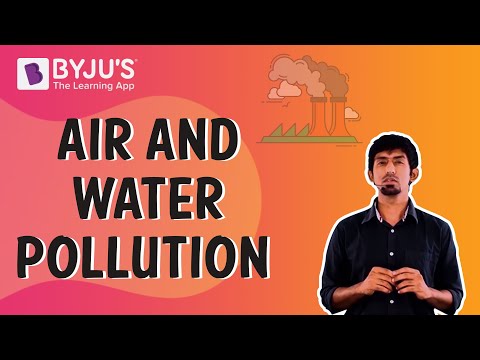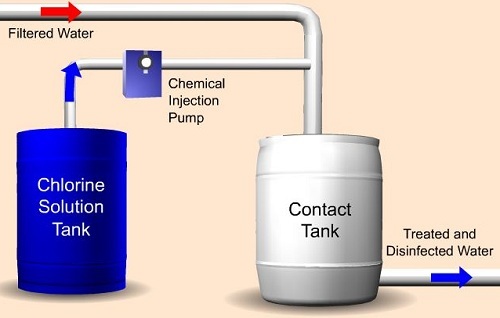According to the CBSE Syllabus 2023-24, this chapter has been removed from NCERT Class 8 Science textbook.
Introduction to Air Pollution
In chapter 18 of class 8 Science, we study the harmful changes taking place in our surroundings and their effects on our lives. The substance that contaminates air and water are known as pollutants. Air gets polluted from natural sources, and smoke and dust arise from forest fires or volcanic eruptions. Pollutants such as power plants and automobile exhaust, and burning of firewood are man-made pollutants. Carbon dioxide, nitrogen oxides, carbon monoxide, methane and sulphur dioxide are the major pollutants of air. Increasing levels of carbon dioxide lead to global warming.
Pollution
Environmental pollution refers to undesirable changes in the surroundings that have adverse effects on plants, animals and other biological and physical components of the environment.
- A substance that causes pollution is called a pollutant. Pollutants can be in liquid, solid or gaseous form.
- A substance becomes a pollutant when its concentration is greater than the natural abundance, and this increase in concentration is either due to human activities or natural phenomena.
- Types of pollution: Air pollution, water pollution, soil pollution, sound pollution, light pollution, etc.
For more information on Air and Water Pollution, watch the below video

To know more about Types of Pollution, visit here.
Air Pollution
Air pollution is the introduction of pollutants, organic molecules, or other hazardous substances into earth’s atmosphere.
Sources:
a) Natural – forest fire, dust storms, and volcanic activity
b) Man-made – power plants, homes, industries, oil refineries, and transportation
Effects:
- Causes allergies, diseases and even death in humans.
- Causes birth defects in newborn babies.
- Endangers animal health and welfare of plants and vegetation.
To know more about Air Pollution, visit here.
How Crucial Are Air and Water?
Water
- The major sources of water are streams, rivers, lakes, and oceans on the earth’s crust.
- It plays a significant role in sustaining life on Earth.
- It is widely used for human activities such as agriculture, drinking, washing, cleaning, etc.
Air
- Air is inevitable in our lives.
- The oxygen in the air is essential for the animals to survive.
- Oxygen helps to produce energy in their bodies.
Air Pollution – What and How
Air Pollutants
The substances, which accumulate in the air in high enough concentration that is hazardous to all organisms or to materials exposed to the air are called air pollutants.
- These may be present as solid particles, liquid droplets or gases.
- Examples: Methane, chlorofluorocarbons, particulate matter, sulphur dioxide, nitrogen dioxide, carbon monoxide, lead, etc.
Carbon Dioxide and Carbon Monoxide
Sources of carbon dioxide: cement production, deforestation and burning of fuels like gasoline, natural gas, oil, coal, and wood.
Sources of carbon monoxide (a toxic air pollutant): incomplete combustion of carbon-containing compounds especially fuels.
Sulphur and Nitrogen
Nitrogen dioxide (NO2) and sulphur dioxide (SO2) are major air pollutants.
Sources: Petroleum refineries, combustion of fossil fuels like coal in power plants.
Effects:
- Respiratory problems, including permanent lung damage.
- Acid rain.
- Photochemical smog, causes breathing difficulties.
Particulate Matter
Particles of solid or liquid that remain suspended in air, water or gas are called particulates. For example, dust, pollen, debris, soot, acid droplets and smoke.
Causes: Combustion, construction, road dust, power plants, industries, deforestation and agricultural activities.
Effects:
- Respiratory and heart diseases.
- Asthma
- Birth defects
Smog
Smog is made up of smoke and fog.
Types: Classical smog, Photochemical smog
1. Classical smog:
- This type of smog occurs in areas with a humid climate and high concentrations of sulphur oxides in the air.
- It is a mixture of smoke, fog, and mainly sulphur dioxide gas.
2. Photochemical smog:
- This type of smog is prevalent in areas with dry and sunny climate and large numbers of automobiles.
- It is formed primarily as a result of chemical interactions between nitrogen oxides and sunlight.
Effects:
- Breathing difficulties such as asthma, cough, and wheezing.
- Inhibits plant growth and can cause widespread damage to crops and forests.
- Photochemical smog leads to the corrosion of metals, building materials, and painted surfaces.
CFCs
Chlorofluorocarbons (CFCs) are compounds of chlorine, fluorine, and carbon.
Uses:
Components of aerosol sprays.
Refrigerants in refrigerators, ACs, and cooling plants.
Effects:
- CFCs destruct the ozone layer that protects the Earth from the sun’s ultraviolet (UV) radiation.
- UV exposure can lead to skin cancer, suppression of the immune system and eye damage.
Taj Mahal
Effects of Air Pollution on the Taj Mahal
- Carbon dioxide, sulphur dioxide, and nitrogen dioxide react with the water vapour present in the atmosphere to form carbonic acid, sulphuric acid, and nitric acid, respectively.
These acids drop down with rain, making it acidic in nature.
Reactions involved:
CO2(g) + 2H2O(l)→2H2CO3(aq)
2SO2(g) + O2(g) + 2H2O(l)→2H2SO4(aq)
4NO2(g) + O2(g) + 2H2O(l)→4HNO3(aq)
Effects on the Taj Mahal:
- Acid rain corrodes the marble of the monument.
- Air pollution is turning the white marble into black.
Global Warming
Greenhouse Gases
- The gases which are responsible for the greenhouse effect are called greenhouse gases.
- Examples: Water vapour, nitrous oxide, carbon dioxide and methane.
Greenhouse Effect
- Most of the solar radiation passes through the atmosphere.
- The earth’s surface radiates heat back toward space.
- A part of it is trapped by the greenhouse gases in the earth’s atmosphere.
- This effect maintains the liveable temperature on the earth’s surface.
Global Warming
- The increase in the average temperature of the earth’s atmosphere due to excess greenhouse gases is called as global warming.
- Causes: Deforestation, industries, oil refineries, power plants, excess burning of fossil fuels like natural gas, oil, and coal, etc.
Effects of Global Warming
- Warmer climate: On average, the earth’s temperature has become warmer than earlier.
- Natural calamities: There is an increase in the occurrence and severity of natural calamities such as floods, cyclones, earthquakes, etc.
- Rise of sea level: Due to global warming, there is a rise in sea levels due to the melting of the polar ice caps.
- Severe weather events: Shifting of the climatic pattern has been observed across the globe.
To know more about Global Warming, visit here.
What Can We Do
Measures to Reduce Air Pollution
- Encourage the use of CNG: It is a cleaner fuel as compared to petrol and diesel.
- Use of unleaded petrol: The unleaded petrol does not emit harmful gases into the environment.
- Proper waste management: Maintains hygiene by proper disposal of waste to areas where it can be left, incinerated or disposed of in a safe manner.
- Use of public transport or carpooling: It is economical, eases congestion on roads and also reduces emissions to a large extent.
Water Pollution – Introduction
Water Pollution
Water pollution is the contamination of water bodies with harmful waste.
Causes:
- Urbanization
- Industries
- Agriculture
- Religious and Social Practices etc.

To know more about “Water Pollution Causes”, visit here.
Not so Holy Ganga
Water Pollutants
- The substances that pollute water are called water pollutants.
- Examples: Detergents, chemicals dumped by hospitals, Insecticides and herbicides etc.
Effects of Water Pollution on the River Ganga
- Towns and cities, through which the river flows, throw large quantities of garbage, untreated sewage, dead bodies, and many other harmful things directly into the river.
- Pollution in Ganga is choking the aquatic life and hindering the growth of plants.
- Ganga is one of the ten most endangered rivers in the world.
Potable Water
Potable Water
- Water, which is suitable for drinking, is called potable water.
- The potable water is free from all contaminants and harmful bacteria.
- The water which is not potable or fit for drinking is called raw water.
Boiling Water
- Boiling the water kills all the microbes.
- It protects us from waterborne diseases.
Filtering Water
- Filtration is the process of separating suspended solid matter from a liquid.
- Filtering water can take away all microbes and impurities up to a certain extent.
Chlorination
- Chlorination is done by adding chlorine tablets or bleaching powder to the water.
- This method is used to kill certain bacteria and other microbes in tap water.

| Also Access |
| NCERT Solutions for Class 8 Science Chapter 18 |
| NCERT Exemplar for Class 8 Science Chapter 18 |
Learn more about pollution and other related topics, including NCERT class 8 Science notes, at BYJU’S.
Also Read:-
| Air, Water and Soil Pollution | Types of Pollution |
Frequently Asked Questions on CBSE Class 8 Science Notes Chapter 18 Pollution of Air and Water
What is Air pollution?
Air pollution is the contamination of the indoor or outdoor environment by any chemical, physical or biological agent that modifies the natural characteristics of the atmosphere.
What are some of the reasons for River pollution?
1. Urban development 2. Improper sewage wastage 3. Radioactive wastage 4. Oil spills 5. Chemical waste dumping
What are the uses of Sulphur?
It is used for making car batteries, fertilizer, oil refining, water processing, and mineral extraction. Other applications for sulfur-based chemicals include rubber vulcanization, bleaching paper, and product making such as cement, detergents, and pesticides.
Comments